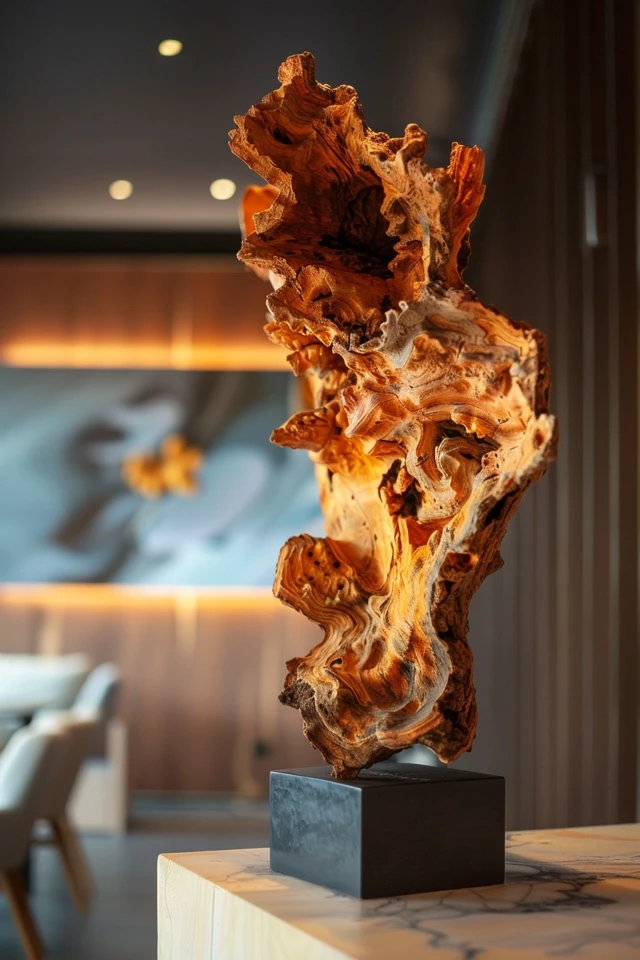Have you ever wondered how those beautiful and intricate tree burls are formed? It’s a fascinating process that involves encouraging natural growth in trees. In this article, I will guide you through the steps of creating a tree burl, empowering you to embark on your own DIY tree burl project. Let’s dive in!
Key Takeaways:
- Tree burls are highly valued for their unique and twisted grain patterns.
- Inducing the formation of burls artificially can be challenging and time-consuming.
- Harvesting burls should be done carefully to avoid damaging the tree.
- Burls can be found on various tree species and in both natural and urban settings.
- Working with burls requires special techniques due to their unique grain patterns.
What Makes a Tree Burl?
A tree burl is an abnormal growth on a tree’s stem, roots, or branches. The exact cause of burl formation is still not completely understood, but it can be attributed to factors such as genetic tendencies, physical injuries, environmental stress, or diseases. Burls are characterized by their twisted and contorted grain patterns, which create unique and visually appealing figures in the wood.
The formation of burls is often accompanied by disruptions in the tree’s growth hormones due to the presence of viruses, fungi, or bacteria. The crown gall bacterium, in particular, has been associated with burl formation.

Finding and Harvesting Tree Burls
Finding burls can be an exciting adventure for any woodworking enthusiast. These unique growths can be found on various tree species, whether you’re exploring forests or urban areas. While burls are more commonly discovered on the roots of trees, they can also be found on the trunk and branches. However, burls on the roots often go unnoticed due to their hidden underground location.
When searching for burls, it’s helpful to know which tree species are more likely to have them. Trees such as cherry, maple, oak, ash, and walnut are known to have a higher prevalence of burls. Keep an eye out for irregularities in the bark and growth patterns, as these can indicate the presence of a burl.
Once you’ve located a burl, the next step is to carefully harvest it. Harvesting a burl involves cutting it out from the tree, which can be done using a chainsaw or by digging up the roots if the burl is underground. It’s important to exercise caution during the harvesting process to avoid damaging the tree or leaving large wounds that could become infected.

Burl Hunting Tips:
- Inspect tree bark for anomalies and twisted grain patterns.
- Focus on tree species known to have a higher likelihood of burl formations.
- Explore both forested areas and urban settings, as burls can be found in both environments.
- When harvesting, use a chainsaw or carefully dig up the roots depending on the burl’s location.
- Leave the surrounding tree tissues undisturbed to promote healing and minimize the risk of infection.
Remember, burls are a precious natural resource, and sustainable harvesting practices are crucial for preserving the health and longevity of the trees. By following these guidelines, you can enjoy the thrill of finding and harvesting burls while ensuring the long-term well-being of our forest ecosystems.

Working with Tree Burls
When it comes to working with burls, it’s important to understand that their unique grain patterns and characteristics require some special considerations. The interlocking circles of burl grain make it ideal for turning on a lathe, allowing you to cut in any direction without significant shape changes during drying.
One key aspect of working with burls is using sharp tools. Sharp scrapers are particularly effective in shaping the intricate details and contours of burls. The sharpness ensures clean cuts and minimizes tear-out, allowing you to fully showcase the beauty of the burl grain.
Another crucial step in working with burls is sanding. Start with a coarse grit and gradually work your way up to finer grits, ensuring that you sand the burl thoroughly. This process helps smooth out any imperfections and reveals the stunning patterns hidden within the wood.
When it comes to finishing burls, multiple coats of oil finish are commonly used. Each coat should be sanded before applying the next, allowing the finish to penetrate and protect the wood effectively. This step enhances the natural beauty of the burl wood, bringing out its irregular grain patterns in all their glory.
Overall, working with burls is a rewarding experience for woodworkers and turners alike. The unique grain patterns and intricate details of burls provide endless creative possibilities, making them a popular choice among artisans seeking to create truly one-of-a-kind pieces.

